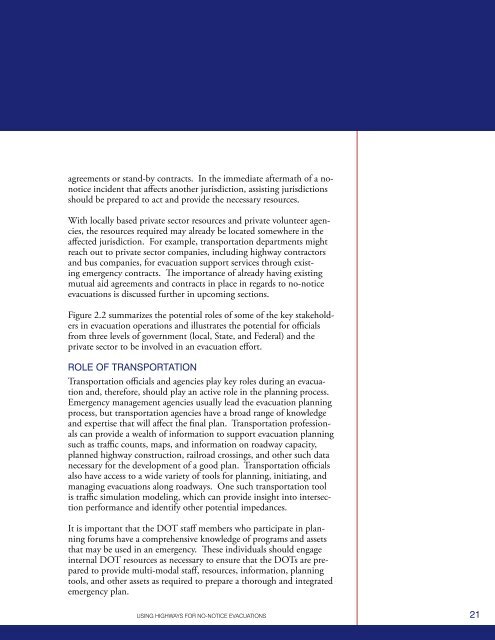using highways for no-notice evacuations - FHWA Operations - U.S. ...
using highways for no-notice evacuations - FHWA Operations - U.S. ...
using highways for no-notice evacuations - FHWA Operations - U.S. ...
You also want an ePaper? Increase the reach of your titles
YUMPU automatically turns print PDFs into web optimized ePapers that Google loves.
agreements or stand-by contracts. In the immediate aftermath of a <strong>no</strong><strong>no</strong>ticeincident that affects a<strong>no</strong>ther jurisdiction, assisting jurisdictionsshould be prepared to act and provide the necessary resources.With locally based private sector resources and private volunteer agencies,the resources required may already be located somewhere in theaffected jurisdiction. For example, transportation departments mightreach out to private sector companies, including highway contractorsand bus companies, <strong>for</strong> evacuation support services through existingemergency contracts. The importance of already having existingmutual aid agreements and contracts in place in regards to <strong>no</strong>-<strong>no</strong>tice<strong>evacuations</strong> is discussed further in upcoming sections.Figure 2.2 summarizes the potential roles of some of the key stakeholdersin evacuation operations and illustrates the potential <strong>for</strong> officialsfrom three levels of government (local, State, and Federal) and theprivate sector to be involved in an evacuation ef<strong>for</strong>t.Role of TransportationTransportation officials and agencies play key roles during an evacuationand, there<strong>for</strong>e, should play an active role in the planning process.Emergency management agencies usually lead the evacuation planningprocess, but transportation agencies have a broad range of k<strong>no</strong>wledgeand expertise that will affect the final plan. Transportation professionalscan provide a wealth of in<strong>for</strong>mation to support evacuation planningsuch as traffic counts, maps, and in<strong>for</strong>mation on roadway capacity,planned highway construction, railroad crossings, and other such datanecessary <strong>for</strong> the development of a good plan. Transportation officialsalso have access to a wide variety of tools <strong>for</strong> planning, initiating, andmanaging <strong>evacuations</strong> along roadways. One such transportation toolis traffic simulation modeling, which can provide insight into intersectionper<strong>for</strong>mance and identify other potential impedances.It is important that the DOT staff members who participate in planning<strong>for</strong>ums have a comprehensive k<strong>no</strong>wledge of programs and assetsthat may be used in an emergency. These individuals should engageinternal DOT resources as necessary to ensure that the DOTs are preparedto provide multi-modal staff, resources, in<strong>for</strong>mation, planningtools, and other assets as required to prepare a thorough and integratedemergency plan.USING HIGHWAYS FOR NO-NOTICE EVACUATIONS21
















